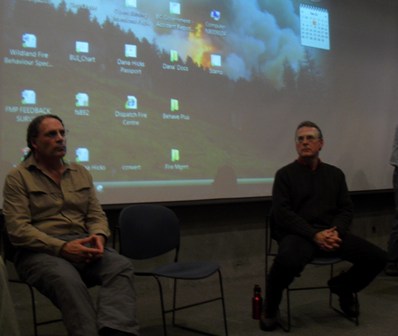Managing Mountain Pine Beetle-Attacked Forests
By 250 News

Bruce Rogers (l) and John Pousette (r) take questions at MPB info session at UNBC
Prince George, B.C.- Determining how best to manage the aftermath of the mountain pine beetle epidemic all comes down to examining the trade-offs -- both the economic ones and ecological ones -- of any course of action.
And speaking to approximately 60 people at an information session at UNBC's Weldwood Theatre last night, Prince George Forest District Tenures/Fibre Officer, John Pousette was one of four researchers with the Ministry of Forests to offer some insights into the science that is going into forest management since the epidemic hit.
Pousette presented the findings of his research into the implications of the remaining live pine trees and advanced regeneration (unaffected species like spruce and balsam) on future timber supply in MPB-attacked forests in Central B.C..
With the current annual allowable cut of 14.9-million cubic metres set in 2004 to deal with the MPB epidemic, it is forecast to drop down to about 6.64-million cubic metres in the 'mid-term' years -- the 15-60 years after the MPB trees have been salvaged and the new forest is maturing. Pousette's first-of-its-kind study looked at 1300 plots in the Prince George and Vanderhoof Forest District and his research data shows that some short-term pain could lead to long-term gain.
Pousette said with approximately 130-thousand hectares of MPB-attacked stands with more advanced regeneration in the region -- 70-thousand ha in the Prince George area and some by Fort St. James -- if left unharvested, those stands could fill that mid-term gap by one-million cubic metres per year, starting at year 15. "Naturally, we don't get to salvage as long," said Pousette. "But, at the same time, we increase that mid-term significantly."
Pousette admitted there's significant uncertainty in timber supply modeling: everything from the model used, to trying to predict future demand for the product. But he said his study shows that advanced regeneration can be incorporated into timber supply modeling techniques, how those stands are priorized for salvaging matters, and, if left unharvested, those stands could fill some of the mid-term gap in the AAC.
Previous Story - Next Story
Return to Home









